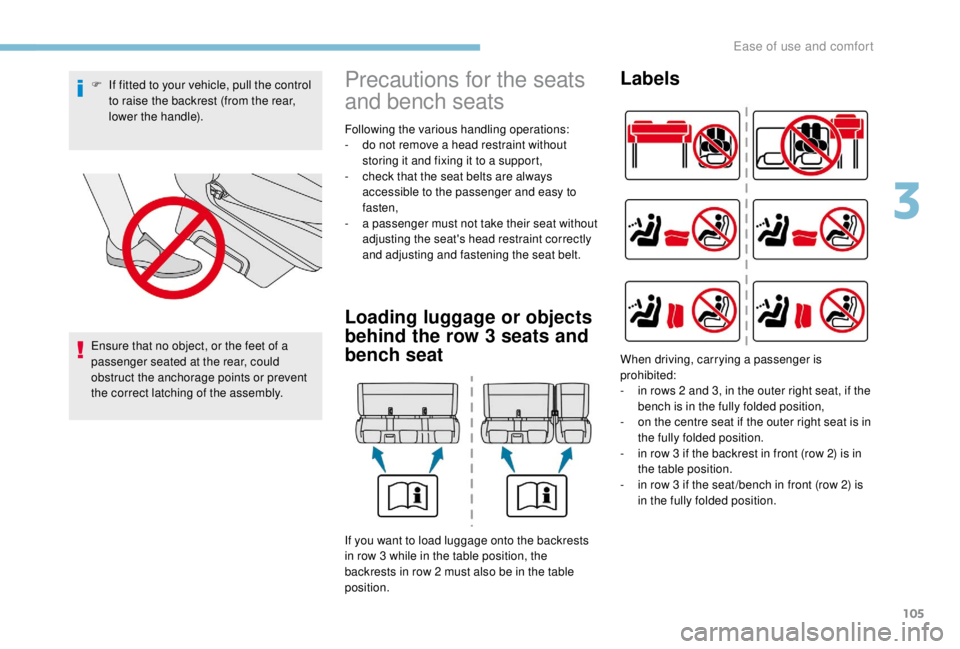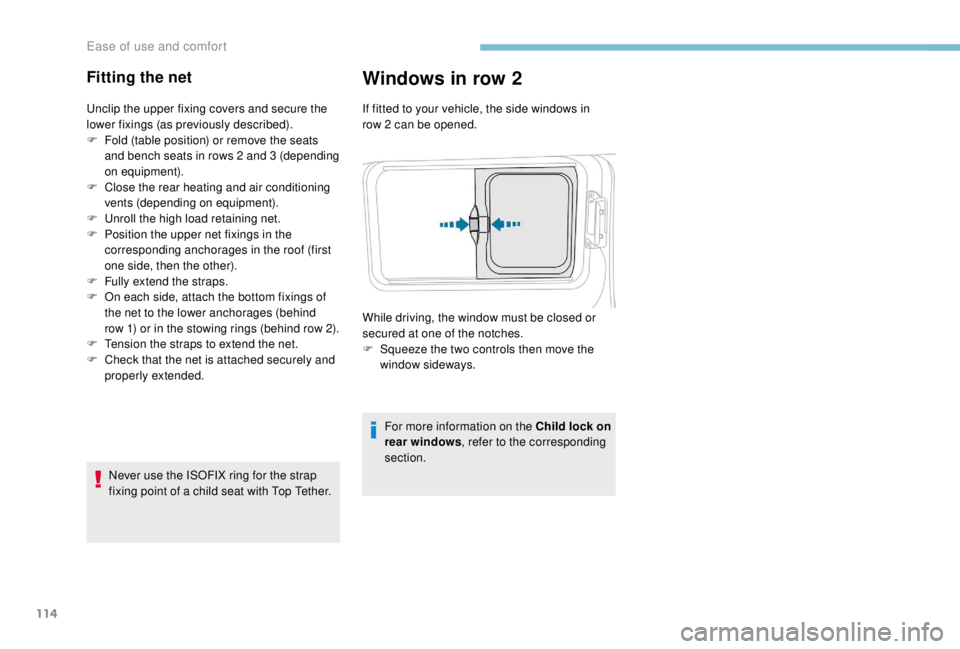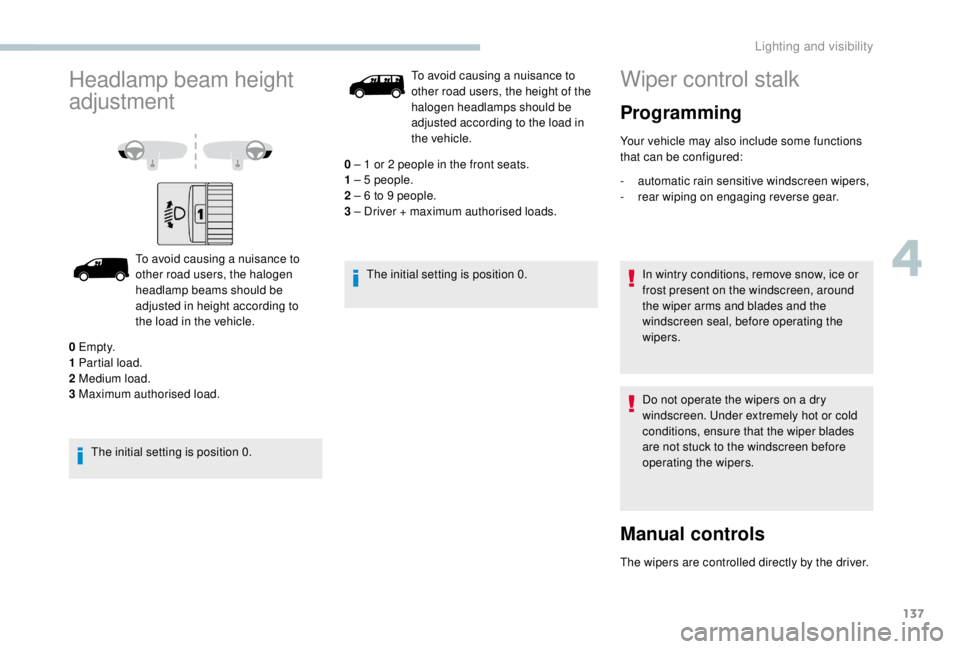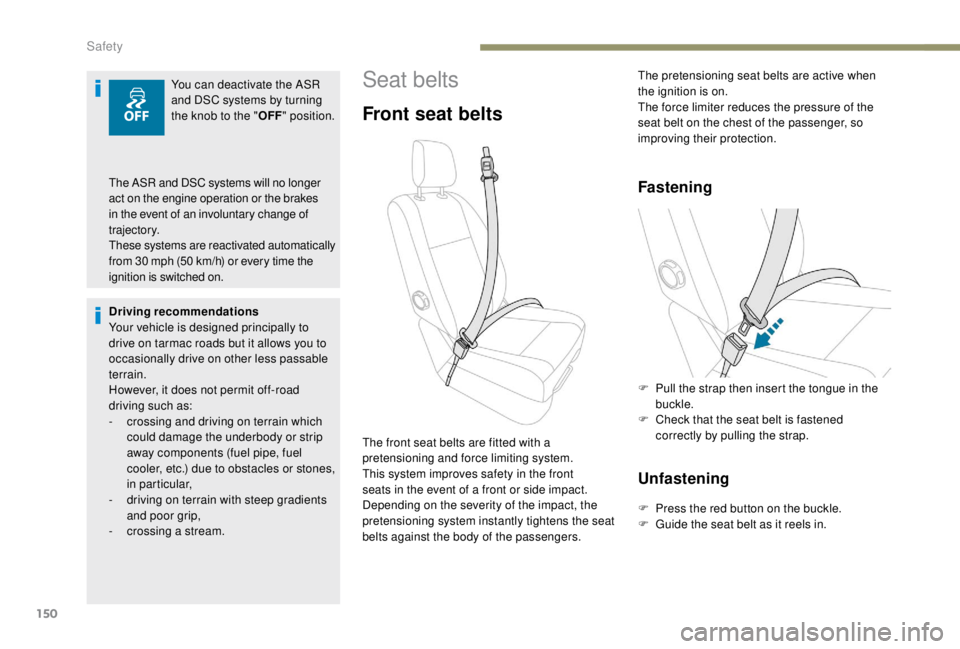Page 95 of 416

93
Adjusting the height of the
head restraint
The head restraint has a frame with
notches which prevents it from lowering;
this is a safety device in case of impact.
The adjustment is correct when the
upper edge of the head restraint is
level with the top of the head.
Never drive with the head restraints
removed; they must be fitted and correctly
adjusted.
Heated bench seat
With the engine running, the bench seat
cushions can be heated.
F
U
se the adjustment wheel to switch on and
select the level of heating required:
0 : Of f.
1 : Low.
2 : Medium.
3 : High.
F
T
o raise a head restraint, pull it upwards.
F
T
o remove the head restraint, press the
lug A and pull the head restraint upwards.
F
T
o put it back in place, engage the head
restraint rods in the apertures keeping them
in line with the seat backrest.
F
T
o lower it, press on the lug A and on the
head restraint at the same time.
Do not use the function when the seat is
not occupied.
Reduce the intensity of the heating as
soon as possible.
When the seat and passenger
compartment have reached an
adequate temperature, you can stop
the function; reducing the consumption
of electrical current reduces fuel
consumption.Prolonged use at the highest setting is
not recommended for those with sensitive
skin.
There is a risk of burns for people whose
perception of heat is impaired (illness,
taking medication, etc.).
There is a risk of overheating the system if
material with insulating properties is used,
such as cushions or seat covers.
Do not use the system:
-
i
f wearing damp clothing,
-
i
f child seats are fitted.
To avoid breaking the heating element in
the seat:
-
d
o not place heavy objects on the seat,
-
d
o not kneel or stand on the seat,
-
d
o not place sharp objects on the seat,
-
d
o not spill liquids onto the seat.
To avoid the risk of short-circuit:
-
d
o not use liquid products for cleaning
the seat,
-
n
ever use the heating function when
the seat is damp.
3
Ease of use and comfort
Page 107 of 416

105
F If fitted to your vehicle, pull the control to raise the backrest (from the rear,
lower the handle).
Ensure that no object, or the feet of a
passenger seated at the rear, could
obstruct the anchorage points or prevent
the correct latching of the assembly.Precautions for the seats
and bench seats
Following the various handling operations:
- d o not remove a head restraint without
storing it and fixing it to a support,
-
c
heck that the seat belts are always
accessible to the passenger and easy to
fasten,
-
a p
assenger must not take their seat without
adjusting the seat's head restraint correctly
and adjusting and fastening the seat belt.
Loading luggage or objects
behind the row 3 seats and
bench seat
If you want to load luggage onto the backrests
in row 3
while in the table position, the
backrests in row 2
must also be in the table
position.
Labels
When driving, carrying a passenger is
prohibited:
-
i
n rows 2 and 3, in the outer right seat, if the
bench is in the fully folded position,
-
o
n the centre seat if the outer right seat is in
the fully folded position.
-
i
n row 3 if the backrest in front (row 2) is in
the table position.
-
i
n row 3 if the seat /bench in front (row 2) is
in the fully folded position.
3
Ease of use and comfort
Page 108 of 416
106
Fixed crew cab
Rear bench seatStorage compartment Under seat storage wells
For more information on ISOFIX
mountings
, refer to the corresponding
section.
If applicable, they are located underneath the
centre and outer left seats.
To gain access from the cab, tilt the required
seat forwards.
This ergonomic bench seat has three seats.
The two outer seats are fitted with ISOFIX
mountings.
If applicable, a storage compartment is
available at the front, underneath the bench
seat.
It comprises a fixed bench seat, seat belts,
storage compartments (depending on
equipment) and side windows.
It is separated from the loading area
by a high-
strength partition offering comfort and safety.
Ease of use and comfort
Page 114 of 416
112
Auxiliary socket (JACK)
It allows the connection of a portable device so
that you can listen to your music files via the
vehicle's speakers.
The management of the files is done using your
portable device.For more information on the use of this
equipment, refer to the Audio equipment
and telematics section.
Loading area fittings
When washing your vehicle, never clean
the inside directly using a water jet.
Stowing rings
Use the stowing rings on the rear floor to attach
your loads.
As a safety precaution in case of sharp braking,
you are advised to place heavy objects as far
for wards towards the cab as possible.
It is recommended that the load is secured
firmly using the stowing rings on the floor.
Load restraint
On the floor, behind the front seats, a
horizontal partition protects the driver and front
passengers against the risk of load movement.
Steel or glass partitions separate the loading
area from the cab.
Ease of use and comfort
Page 115 of 416
113
Seating area fittings
High load retaining net
This allows the use of the entire loading
capacity, up to the roof:
-
b
ehind the front seats in row 1, when the
rear seats (and bench seats) in rows 2
and
3
are folded or removed.
-
b
ehind the rear seats (and bench seats)
in row 2, when the rear seats (and bench
seats) in row 3
are folded or removed.
Upper fixings Lower fixings (behind row 1)
If your vehicle has fixed
one-piece bench seats
or seats and bench seats:
If your vehicle has seats and bench seats or
individual seats on rails : F
O
n each side in row 2, insert the fixings
in the floor anchorages then turn them a
quarter turn to lock them in place (as shown
a b ove).
Place them as close as possible to the end of
the rail.
Lower fixings (behind row 2)
F Unclip the anchorage cover in the roof on each side. F
O
n each side in row 2, insert the fixings in
the floor anchorages (as shown above).
F
U
se the stowing rings.
3
Ease of use and comfort
Page 116 of 416

114
Fitting the net
Unclip the upper fixing covers and secure the
lower fixings (as previously described).
F
F
old (table position) or remove the seats
and bench seats in rows 2
and 3 (depending
on equipment).
F
C
lose the rear heating and air conditioning
vents (depending on equipment).
F
U
nroll the high load retaining net.
F
P
osition the upper net fixings in the
corresponding anchorages in the roof (first
one side, then the other).
F
F
ully extend the straps.
F
O
n each side, attach the bottom fixings of
the net to the lower anchorages (behind
row 1) or in the stowing rings (behind row 2).
F
T
ension the straps to extend the net.
F
C
heck that the net is attached securely and
properly extended.
Never use the ISOFIX ring for the strap
fixing point of a child seat with Top Tether.
Windows in row 2
If fitted to your vehicle, the side windows in
row 2 can be opened.
For more information on the Child lock on
rear windows , refer to the corresponding
section.
While driving, the window must be closed or
secured at one of the notches.
F
S
queeze the two controls then move the
window sideways.
Ease of use and comfort
Page 139 of 416

137
Headlamp beam height
adjustment
To avoid causing a nuisance to
other road users, the halogen
headlamp beams should be
adjusted in height according to
the load in the vehicle.
The initial setting is position 0. To avoid causing a nuisance to
other road users, the height of the
halogen headlamps should be
adjusted according to the load in
the vehicle.
0 – 1 or 2 people in the front seats.
1 – 5
people.
2 – 6 to 9 people.
3 – Driver + maximum authorised loads.
The initial setting is position 0.
0
Em pt y.
1
Partial load.
2
Medium load.
3
Maximum authorised load.
Wiper control stalk
Programming
Your vehicle may also include some functions
that can be configured:
-
a
utomatic rain sensitive windscreen wipers,
-
r
ear wiping on engaging reverse gear.
In wintry conditions, remove snow, ice or
frost present on the windscreen, around
the wiper arms and blades and the
windscreen seal, before operating the
wipers.
Do not operate the wipers on a dry
windscreen. Under extremely hot or cold
conditions, ensure that the wiper blades
are not stuck to the windscreen before
operating the wipers.
Manual controls
The wipers are controlled directly by the driver.
4
Lighting and visibility
Page 152 of 416

150
Seat belts
Front seat belts
Fastening
Unfastening
F Press the red button on the buckle.
F G uide the seat belt as it reels in.
The front seat belts are fitted with a
pretensioning and force limiting system.
This system improves safety in the front
seats in the event of a front or side impact.
Depending on the severity of the impact, the
pretensioning system instantly tightens the seat
belts against the body of the passengers. The pretensioning seat belts are active when
the ignition is on.
The force limiter reduces the pressure of the
seat belt on the chest of the passenger, so
improving their protection.
F
P
ull the strap then insert the tongue in the
buckle.
F
C
heck that the seat belt is fastened
correctly by pulling the strap.
You can deactivate the ASR
and DSC systems by turning
the knob to the "
OFF" position.
The ASR and DSC systems will no longer
act on the engine operation or the brakes
in the event of an involuntary change of
trajectory.
These systems are reactivated automatically
from 30
mph (50
km/h) or every time the
ignition is switched on.
Driving recommendations
Your vehicle is designed principally to
drive on tarmac roads but it allows you to
occasionally drive on other less passable
terrain.
However, it does not permit off-road
driving such as:
-
c
rossing and driving on terrain which
could damage the underbody or strip
away components (fuel pipe, fuel
cooler, etc.) due to obstacles or stones,
in particular,
-
d
riving on terrain with steep gradients
and poor grip,
-
c
rossing a stream.
Safety